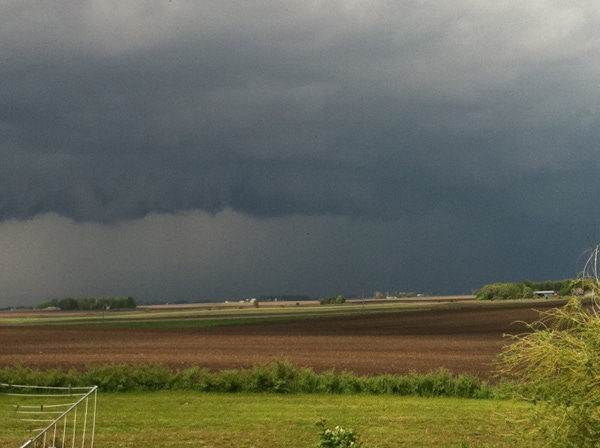Severe weather is a fact of life this time of year. Proper preparation can help you survive the storm.

It’s interesting to note that when George Gershwin wrote the iconic ballad “Summertime and the livin’ is easy,” he didn’t pen an equally melodic tribute to spring.
Not that springtime hasn’t received its share of accolades. Indeed, little can beat a beautiful spring day with gentle sunshine and a light breeze. But spring has a dark side, and when it throws a temper tantrum, the thunder and a whole lot more will roll.
And that spells trouble for everyone, particularly cattlemen. Cattle loss can occur in several scenarios, says Glenn Selk, Oklahoma State University Extension emeritus animal scientist. “Livestock may be killed, lost, or stolen during a stormy situation. An accurate accounting of livestock and property is essential to a cattle operation’s storm preparedness,” he says.
Selk suggests keeping a current inventory of all animals and the pastures where they��’re located. “Individual animal ID tags on all animals have several other purposes, but can become extremely valuable if cattle become scattered or even stolen. If these records are computer-based, consider having a back-up copy stored at a neighbor’s or a relative’s house,” he says.
Here are some suggestions for protecting cattle from the aftermath of storms:
• Gather and dispose of trash, limbs, wire and damaged equipment that could harm livestock. Clear and repair damaged fences.
• Make sure livestock have plenty of water and food that haven’t been contaminated by pollutants. In some cases, it’s necessary to truck in water and food, or to remove livestock from contaminated areas.
• Properly and immediately dispose of dead carcasses. If rendering plants are still available in your area, they may process some dead animals. Those not processed should be buried away from water bodies at least 3-4 ft. deep and covered with quick-lime to accelerate decomposition.
• Observe livestock for signs of infectious disease such as pneumonia or foot rot. All animals that die immediately following a disaster should be necropsied by a veterinarian.
• Spray livestock with insect repellent in case of floods to protect against mosquitoes that may carry disease.
“There are other things to consider when clearing the storm debris,” Selk says. “Be mindful of fiberglass insulation that’s often scattered across pastures. Gather as much of the big pieces as possible so cattle don’t consume large amounts of the insulation.”
Plastic bags can also be ingested by cattle and cause compacted intestinal tracts. Avoid junk or debris that could be a source of lead. “This could really be an issue after a severe thunderstorm or tornado with wind damage that results in roofing debris spread across the pasture,” he says. “Don’t allow cattle access to pastures where old car batteries or sources of crank case oil (old abandoned vehicles or machines) may cause lead poisoning.”
Protect yourself
It’s equally important to take steps to protect yourself, your family and others, says Mary Knapp, Kansas state climatologist and director of the Kansas Weather Data Library at Kansas State University. Here are her recommendations on steps that families and businesses alike can take to be as prepared as possible:
• Review your severe weather safety plans. Consider how you’ll monitor changing weather conditions. It’s a good idea to have more than one method to receive the warning.
• Buy a weather radio. Using a National Oceanic and Atmospheric Administration (NOAA) weather radio brings a nationwide network of radio stations broadcasting continuous weather information directly into your home or business. These radios now feature special area messaging called "SAME," which allows you to select the area of interest when receiving warnings and alerts. Some versions have additional features such as strobe lights and bed shakers that can serve special needs.
• Sign up to receive text messages and other alerts over the phone. Local radio and television stations also are good way of getting up-to-date information. Remember tornado sirens are designed to alert people to danger in an outdoor setting; they’re not designed to be heard inside buildings.
• Determine where you’ll seek shelter. A designated storm shelter near where you live or work would be the first choice. If one isn’t available, seek shelter at the lowest level, placing as many walls between you and the outside as possible. Interior rooms, such as closets and bathrooms, are good choices. Plan this location in advance and talk to family members and/or work colleagues in order to respond quickly when needed.
• Store emergency supplies in your shelter. This should include a flashlight, portable radio and batteries, water and other essentials. See a detailed list at http://www.ready.gov/.
• When traveling, be alert to conditions that may develop along your route. In many cases, it’s safer to stop and allow the storm to pass rather than try to drive through it. Remember that a highway overpass isn’t a safe shelter; in addition to the storm danger, you’re at risk from other vehicles.
“Remember that not all tornadoes have the clear, visible funnel,” Knapp says. “Tornadoes can be completely wrapped in rain, making them difficult to detect with the naked eye.”
A final caution is that severe storms are also a source of lightning, high winds, hail and flash floods. Any of these hazards can be just as deadly as a tornado, Knapp adds.
For more on severe weather preparedness, go to http://texashelp.tamu.edu.
About the Author(s)
You May Also Like
.png?width=300&auto=webp&quality=80&disable=upscale)


